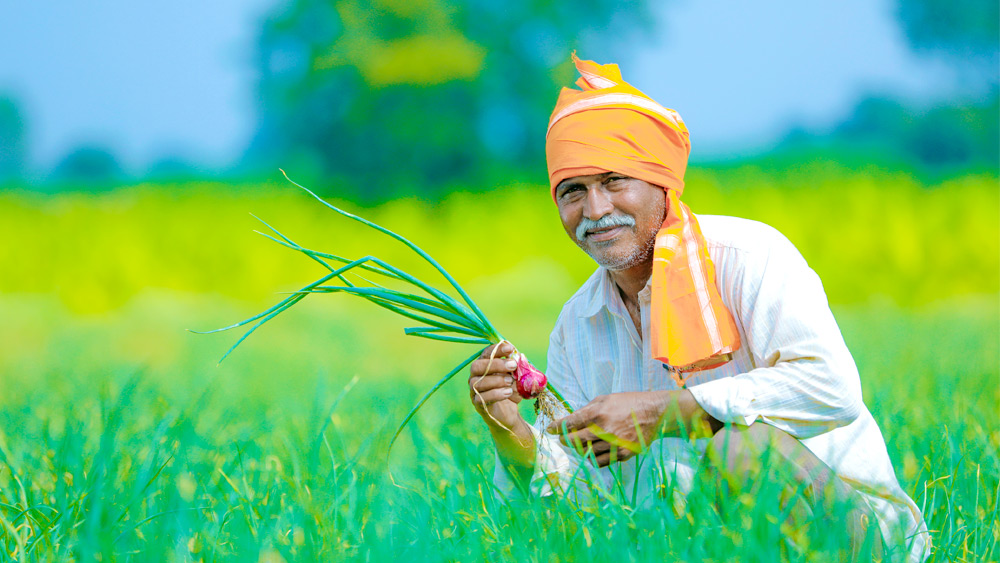Union Budget 2022: Top Agriculture Takeaways

As India steps into the last quarter in its journey towards India @100, the Union Budget 2022 reveals the government’s provisions for those that are at the heart of our sustenance, farmers. Through the Budget, the government emphasizes farmer welfare via income generation and promotes the idea of agriculture as an economic activity that generates value for the farmer.
An outlay of ₹ 2.37 Lakh Cr (33 billion USD) has been announced to farmers for the procurement of wheat and paddy under the minimum support price. This is expected to benefit 16 million farmers. To help the sector further, ₹ 1.32 Lakh Cr (18 billion USD) has been allocated to departments under the agriculture ministry for subsidies to farmers across the supply chain.
Kisan Drones will be deployed for crop assessment, the spraying insecticides and nutrients, and land survey, which will help in land use planning, more targeted allocation of resources, early settlement of insurance claims, digitization of land records. It will also create employment among the rural youth, reduce costs for farmers, lead to safe farming practices, and increased productivity. This initiative is additionally indirectly supportive of start-ups already working in the Drone Tech sector, such as Marut Drones, who, in partnership with Research and Innovation Circle of Hyderabad (RICH) and other organisations including the Government of Telengana, have built and piloted drones for safely spraying pesticides across large areas of cropland (over 30,000 acres sprayed) and sowing seedballs for afforestation (over 4.5 lakh seedballs sowed).
There is a renewed focus on chemical free & natural farming, in what is called ‘zero budget natural farming’, beginning with 5-km-wide corridors along the river Ganga. To mitigate the perennial issue of water shortages that impact agriculture, ₹ 44,000 Cr (6 billion USD) has been allocated to the Ken-Betwa project for interlinking rivers for improved irrigation. This is projected to benefit 900,000 farmers. Also announced were schemes to assist farmers from socio economically depressed communities, who wish to take up agroforestry.
To move agriculture to the next level, a focus on the needs of the Indian farmer is a must. The budget looks at giving a boost to the agri-tech sector. This is expected to help farmers move towards digitisation, obtain high-value, high-return commodities, and boost their incomes. Start-up and rural enterprises will be financially incentivized through special funds with blended capital—such as the Farm Sector Promotion Fund (FSPF)—under the co-investment model through NABARD (National Bank for Agricultural and Rural Development). And Farmer Producer Organisations (FPOs) will be supported via these funds and through technology such as online portals for various purposes.
A Public-Private-Partnership model between public sector research institutions and their extensions and private agri-tech players has been introduced. Further, states would be encouraged to revise the syllabi of agricultural universities to meet the needs of organic and modern-day agriculture and value addition.
An oil imports scheme has been announced with the aim to lower the country’s dependence on imports of oil seeds by augmenting their domestic production. This is expected to lead to more farmers switching to growing oilseeds, which will help them earn more. It will also continue to bolster the longstanding National Mission on Oilseeds and Oilpalm which aims to increase India’s edible oil production and reduce reliance on imports, and under which various bodies such as RICH and Evergreen Energy Enterprises Inc. are teaming up apply technology to palm oil cultivation. It will also help India move towards its goal of Atmanirbhar Bharat.
The year 2023 has been declared as the International Year of Millets. Since 2018, with Millets having been declared a ‘nutri-cereal’, India is trying to enhance the domestic consumption of millets. Budget 2022 makes provisions for supporting the post-harvest value addition of millets and branding millet products nationally and internationally.
Finally, for a direct contribution to atmospheric CO2 reduction, part of the fuel in thermal power plants will be 5–7% of the biomass pellets produced in the country. This will result in 38 million metric tons of CO2 reduction annually.
Budget 2022 has made provisions aimed at a long-term sustainability, boosting farmers’ incomes, and improving our competitiveness in global markets. However, there is scope for improvement in terms of detailing approaches, setting realistic targets and creating a policy framework to attract greater investment.





